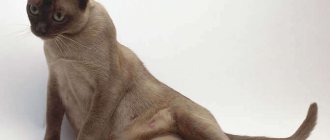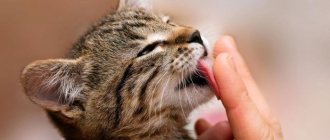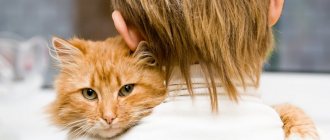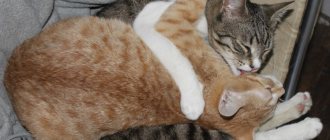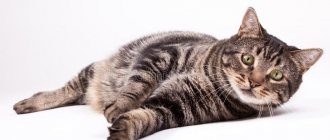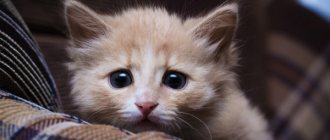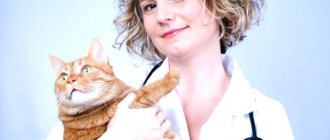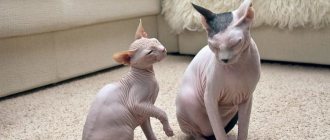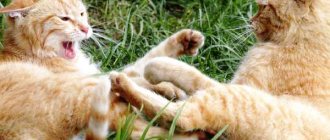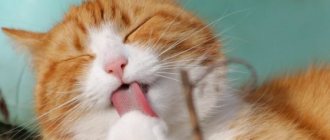Cats do not express their emotions as clearly as dogs. Sometimes cat behavior is difficult to interpret, but this does not mean that your pet will forever remain a mysterious creature for you.
The sounds he makes, body movements and everyday behavior will tell you how your furry family member feels. If you pay attention to them, you can not only learn to understand your pet’s personality traits and habits, but also see the slightest changes in his mood and health.
Meowing
An adult cat meows less often than a kitten, but in a very special way. If the tone is low, it means she is dissatisfied or unhappy for some reason. A high tone means she is in good spirits, and if the meowing is repeated, it means she wants your attention. You will soon learn to understand what your pet is “saying”: “let me go,” “feed me,” “caress me.”
Interestingly, meows are almost always directed at humans, and almost never at other cats. So listen - she is talking to you!
Abandoned Angel
Don't forget that our pets can get sick too.
The difficulty is that, unlike you and me, they themselves will not tell about it...
Indeed, sometimes it is not easy to understand that something is wrong with a cat. But it also happens that frivolous owners do not pay attention to any deviations in the animal’s behavior, which can lead to dire consequences. We urge you to be vigilant and monitor the condition of your pet!
The main signs of a healthy cat:
- the pet is cheerful, quite active - has a good appetite - if the cat is not sleeping, its nose is moist and cool - the fur is shiny and smooth - the mucous membranes are clean and pink - the eyes are clear, there is no excessive discharge
We also note the following significant indicators:
- the body temperature of an adult animal should be 38-39°C (for sphinxes up to 41.5°C), of a kitten up to 39.6°C - the normal heart rate of an adult animal is 110-150 beats per minute, the pulse of kittens is up to 200 beats per minute minute - the breathing rate of an adult animal is usually 20-35 movements per minute, kittens can breathe more often
Non-compliance with the norm can manifest itself as a result of various stresses - for example, moving, changing food or even cat litter. However, only a consultation with a specialist will give an accurate answer as to whether everything is okay with your pet and what to do in each specific case. In this article we will talk about what points should not be overlooked.
Above we have listed only some external criteria for a healthy state. When interacting with your pet, do not be lazy to periodically examine it for external abnormalities. Check your teeth and gums (pay attention to whether there is a strong unpleasant or unusual odor from your mouth), ears, skin, etc. This will not take much time, but such an “examination” will easily detect local problems and can help diagnose any disease at an early stage.
A serious symptom is a change in body weight. Monitor your pet's weight! Some diseases may not manifest themselves at all at first, but the cat will lose weight. Obesity is also dangerous, because it puts a strain on the heart and can lead to various kinds of ailments.
One of the most important signs that something is wrong with your animal is a change in its behavior and a disruption in its usual routine. To the first we include not only habits, but also eating behavior. Let's look at this in more detail.
If your pet has become too apathetic, constantly sleeps, and gets tired quickly, this should serve as an alarm. Equally, excessively violent activity, agitation, atypical aggressiveness, sleep disturbance, etc. indicate that there is some problem. Remember that we are talking about behavior that is different from usual! If a cat prefers to spend time alone all the time and does not seek human contact, this is normal, but if an affectionate and playful pet who loves to be petted suddenly becomes withdrawn and avoids its owner, it is most likely not okay. Often animals experiencing pain hide from prying eyes. Keep this in mind and note any oddities if any - this will help the veterinarian make a diagnosis.
A cat’s eating behavior and disorders in this area can also tell a lot. Unhealthy is both increased appetite and thirst, and refusal of food and water. If, in addition to these signs, there are others (for example, vomiting, diarrhea, apathy), you should not delay a visit to the doctor.
As for vomiting, there are various reasons for it - overeating and fur in the stomach (if this happens, comb your pet more often and consult a veterinarian about taking malt paste), but it can also be a manifestation of much more serious disorders of the body. As we wrote above, it is important to assess the cat’s condition as a whole and, if several symptoms are present, seek qualified help. If your pet vomits 1-2 times and it doesn’t happen again, and your four-legged friend is alert and doesn’t behave suspiciously, there’s no need to panic. However, pay attention to the presence of blood or bile in the vomit - this is a very alarming sign, as is its strange (for example, green) color.
Speaking of diarrhea, the advice here is similar - monitor the frequency of going to the toilet, the presence or absence of any other manifestations of ill health and impurities in the excrement. Constipation, in turn, is also not the norm. Sometimes it occurs due to intestinal obstruction (for example, if the animal has swallowed a foreign object). In any case, when attempts to cleanse the intestines for several days are unsuccessful or are accompanied by additional signs of illness, it is better to see a veterinarian.
If your pet suddenly begins to walk “smallly” past the litter box or in some other place in the apartment, if urination is too infrequent and difficult, or, conversely, unusually frequent, this may be a consequence of diseases of the urinary system. Before scolding a cat for bad behavior, you need to understand its reasons, because they can be purely medical - the pet, with all its desire, may simply not have time to get to the toilet. If any of the above occur, or if there is blood in the urine or the fluid itself is of an unusual color, visit a doctor as soon as possible.
Neurological disorders are characterized by disorientation, weakness of the limbs, tremor (involuntary shaking), etc. Contact the veterinary clinic if you notice: - your pet has become clumsy - the paws do not obey, muscle weakness - the cat does not hold his head, shakes it - he rested his head against the wall and does not respond to your call, looks at one point and does not react to anything ( collapse) - the pupils are constantly dilated or run around - the animal has convulsions - loss of consciousness Do not ignore such manifestations, because disorders of the nervous system and brain function are very dangerous, and in severe cases, even death is possible.
In the article CAT AND HEAT, we talked about the symptoms of heat stroke and how to prevent it. In the summer, this is a very relevant topic, so we advise you to familiarize yourself with this material when hot days arrive.
At the very beginning we already mentioned the normal rhythm of breathing. In a stressful situation, an animal may breathe more often, and a well-fed pet may well be a little out of breath after active games. However, experts say that the respiratory system of cats as a whole is very vulnerable, and therefore it is worth paying close attention to violations in this area. If breathing is too frequent or, conversely, difficult, if your pet breathes through the mouth, if there are extraneous sounds (wheezing, gurgling, sniffling), if there is shortness of breath or coughing - all these are signs of pathology. Lack of oxygen sometimes leads to irreversible consequences, so if you see that your pet cannot breathe normally, the breathing rhythm is disrupted, and the lips and gums have turned pale or blue, immediately take him to the doctor.
Another point that is very indicative is personal hygiene. Everyone knows that cats are clean. If your four-legged friend has stopped washing himself, he may not have the strength or it hurts to do so. The coat becomes dull, matted, shedding may occur, and the skin becomes yellowish. Excessive licking is also a concern.
So, we talked about the most basic points that may indicate an animal’s illness. We ask you to be sensitive to the condition of your pets, but not to go too far - unfortunately, sometimes people blindly trust advice from the Internet and begin to “treat” their pets themselves. Such “help” can, on the contrary, worsen the problem! Remember that only a veterinarian is qualified to correctly assess the situation and make a diagnosis. Therefore, if you suspect an illness, feel free to go to the clinic, where professionals will provide the cat with the necessary help.
We wish you and your pets health!
Tell friends:
Talking Tail
A cat's tail perfectly reflects the mood of its owner. If the kitten is happy, the tail will be raised vertically. If he is scared, his tail will be tucked between his hind legs. If an adult cat swings its tail widely, it is a sign of irritation or impatience. If your cat is agitated, her tail will move quickly from side to side - this is a real threat. If your kitten's tail twitches, it means he is feeling admiration or curiosity.
Pricked ears are a sign of interest in what is happening around you. If the ears are straight and pointed forward, your cat is relaxed and friendly. But if she flattens her ears, this is a sign of aggression: you better retreat, otherwise you will be attacked.
Scratchy paws
Cats have long learned to use their front paws not only for movement and hunting. With their help, it is easiest for them to communicate with their owners. They have learned to give their paw when asked, or to touch their owner when attention is needed. Modern cats can even point in the direction or point to an object that interests them.
If, upon contact with a person, a cat clenches and unclenches its toes, retracting and pulling out its claws, then this means complete trust . Pussy loves the attention she gets. In this way she shows the owner to continue his actions.
If an animal hides its paws under itself while sleeping, it means the pussy is cold. Thus, the pet tries to maintain its body heat. To make your cat comfortable, you should buy a warm bed for him.
Your cat's habits: more and more curious
Without a doubt, cats have the strangest habits. Have you ever tried to unfold a newspaper and read it when your cat is nearby? She will immediately jump onto the table and settle down in the very center of your reading, and if only someone dares to move her! You won't be able to cheat and replace the newspaper with something else. Nor will you be able to persuade her to move to a much more comfortable pillow or chair. Why? Because while she is sitting on the newspaper, all your attention is focused on her.
If your cat rolls over onto her back and stretches out her paws, this is a sign of complete submission and trust in you. And also a demand for attention. And if she climbs onto your lap and curls up comfortably into a ball, this can hardly be interpreted other than contentment and calmness.
Sound signals
You'll learn a lot about your furry friend once you can understand his "cat vocabulary." Various “meows” and “murks” will tell you when the cat is hungry, bored, scared or in pain.
While some animals prefer to remain silent, occasionally breaking it with a short squeak, others are so “talkative” that they do not allow the owner to get a word in during the “conversation.” Kittens that have a lot of interaction with them when they are young often become sociable as they grow up. It should also be inherent in representatives of certain breeds; these include Siamese and Abyssinian cats.
If your furry friend is scared or feeling confused, he may meow frequently, asking for reassurance.
The number of sounds produced may increase with age. The causes are the development of dementia and visual impairment. Increased volume is often associated with hearing defects that prevent the animal from correctly assessing its voice.
Any changes in the frequency and strength of the sounds made by your pet require contacting a veterinary clinic to rule out the presence of diseases and pain.
- Meowing can serve a variety of purposes. These sounds are made by a cat as gratitude, demand, objection or notification. Some owners find their pets meowing while walking alone around the house (to themselves).
- The "chirps and trills" are used by the cat to get her cubs to follow her. In relation to a person, the animal uses the same sounds to direct the owner to the right place (mainly to a bowl of food). If several pets live in an apartment, you can often hear their active “iridescent” communication.
- Purring is usually a sign of satisfaction. Cats may purr when they are happy or even while eating. However, sometimes sounds indicate anxiety or illness and are a way of self-soothing (similar to children sucking their thumb).
- Growling and hissing indicate that the animal is experiencing irritation, fear, anger or aggression. If you hear such sounds from a cat, it is better to leave it alone.
- Screaming and howling (a loud, prolonged meow) signals that your pet is in a stressful situation (locked in the toilet, looking for you, or in pain).
Hearing such sounds, you need to find the cat and get rid of the problem. Unneutered male cats may howl during mating season. Older animals meow loudly and for a long time when they are disoriented, especially those suffering from cognitive disorders such as dementia. - Chatting and chirping are sounds made by cats while they sit on the windowsill and watch birds or squirrels. This is usually caused by being in an excited state (often due to the desire to snack).
Other physical activities
Cats can communicate with you in other ways, including:
Touch
Cats are known to rub against objects, including people. It's partly a sign of affection, but it's also a message to other cats. This is one way they spread their scent to mark their territory.
The cat "kneads the dough"
Some cats sit on your lap, on your stomach or on your back, and begin to trample you, as if they are kneading dough. This is a relic of their childhood. Kittens knead their mother to get milk, and they associate this with comfort.
Meow
Cats don't meow at each other. They meow only to attract people's attention. Your cat may meow if he is hungry or wants to be petted.
Purring is a sign of satisfaction and relaxation. If you hear your cat howling or making unfamiliar noises, it could be a sign of illness or pain.
"Talking" movements of the ears and head
A cat can “tell” a lot of interesting things with its ears, head and whiskers. She can:
- prick or press ears;
- lower, raise your head;
- point the mustache forward and backward.
These animals do not need to move their heads to hear everything that is happening to the side or behind. To do this, they only need to turn their ears in the direction of the sounds. If the ears perk up, it means the cat is very interested in something and is studying the object. When the animal senses approaching danger, the ears are pressed to the head, the tips pointing back. This way the pet protects its ears.
A cat that feels a surge of happiness and trusts its owner walks with its head held high. At the same time, her ears are pricked up, as if she wants to hear praise, compliments addressed to her, to make sure that she is really loved. Raising your head up can be a gesture demonstrating a dominant position. You can also observe a situation when a cat is driven “into a corner” and needs to defend itself. The ears are pressed down.
In a calm environment, a lowered head may indicate a feeling of peace, boredom or drowsiness. Sometimes a cat lowers its head as a sign of humility, submission, if it is attacked by another cat with which it cannot cope.
By the direction of the whiskers you can determine your pet's mood and emotions. If they are pulled back, the animal intends to attack or defend itself. A mustache pointing forward indicates a relaxed, calm state and pleasant emotions.
The cat demands cleanliness
Cats are very clean animals. They don't like a dirty litter box and won't go into it. If their potty is a mess, then without the slightest remorse they can sit next to you and make a puddle right on the floor. But, as a rule, they will warn you in advance that you need to clean up.
In this case, my cats, for example, begin to deliberately loudly bury something in the pot. At the same time, they will not even touch the filler. They simply tap the edge of the tray with their paw and shout in displeasure. And this is no longer that affectionate “me” when they ask for food. No! This is clearly a curse word! You will realize that they will scream differently. For some reason, at such moments, it seems to me that they are telling me: “Man, come quickly to the tray!”
Hiss
You don't need to be an expert in cat psychology to understand that hissing, high-pitched meows and growls are the animal's declaration of impending danger.
Seeing a neighbor's dog or cat, the pet may begin to defend its territory by making growling sounds. My cats react this way when puppies try to play with them: they don’t release their claws, but they scare them off with hissing and growling.
Sometimes an animal can react this way to an unfamiliar object: a hair dryer, a vacuum cleaner, a washing machine. If a cat hisses at someone on the street, it could be a hedgehog or snake lurking nearby.
How to calm a cat during spring?
The second way to calm an anxious pet in the spring is to give your cat special “anti-sex” pills during the period of heightened instincts. You can find them in almost every veterinary pharmacy. The drugs are divided into two groups: herbal drugs and hormonal tablets.
Interesting materials:
What does a heart tattoo mean? What does a heart tattoo on the shoulder mean? What does an elephant tattoo mean? What does an infinity sign with a feather tattoo mean? What does a panther tattoo on a leg mean? What does a Cerberus tattoo mean? What does it mean to match you? What does it mean that technical support by phone has expired? What does a current account on a card mean? What does it mean that the subscriber’s phone is temporarily unavailable to Tele2?
The cat wants to eat
You definitely won't miss this! The cat won't let you. He will walk in circles around you, not allowing you to pass. Having raised its muzzle and raised its tail high, it will rub against your legs, from time to time making a sound similar to a satisfied “me!” This is the surest sign that it is time for him to have lunch.
There are a number of additional signs. For example, you sat down with something tasty in front of the TV, and although the food from our table is not suitable for cats, they don’t know about it. Cats, like dogs, sometimes beg. And then you will have no peace all evening!
Your pet will rest its forehead against you, butting you like a calf. He will purr, sing songs, look into your eyes, psychologically blackmailing you. With all my appearance, as if saying: “I love you so much, let me eat!” Well, if you are someone completely slow-witted, then without hesitation he can try to take his own with his paw...
Cats are nocturnal animals. They, of course, will sleep a little in the evening, but, as a rule, they announce “rising” at four in the morning. At the same time they wake up very hungry. And at this time you are in the deepest sleep. Therefore, they will try to correct this misunderstanding: for the rest of the night they will sing songs to you under the bedroom door, and if they get into your bed, then without hesitation they will “dig” you out from under the blanket with their paw.
There are several options here. The easiest way is to leave some dry food and water in the evening. Then the cat will get up, eat, and most likely go back to sleep. Or get up with her and run to feed her. It's complicated. Or listen to her/his serenades until the morning.
Let's understand a cat by its sounds
At least 16 sounds are used by cats to communicate . Different cat breeds differ in their talkativeness. Siamese and Oriental cats love to chat with their owners the most. Rumbling and purring are characteristic of small cats. A cat's purring is a symbol of sympathy for its owners and good disposition. By purring, a cat shows its aggressiveness and tells you that it is ready to start a fight; Hissing shows fear and uncertainty about salvation. When a cat is contemplating fight or flight, it snorts and leans its body forward.
Making decisions
Whiskers raised forward and ears pressed to the head indicate that the cat is making a decision and is a little afraid of the possible consequences: stay in place or run? Should you go outside where it's raining or stay inside? In addition, when a cat is faced with a difficult choice, it waves its tail, as if swaying it. As soon as the decision is made, the tail will immediately calm down.
Muzzle and mustache
Not everyone knows, but cats have very expressive facial expressions. This helps some owners find a common language with their pets.
- Antennae pointing forward indicate increased interest in something.
- If the pet spreads them apart, it means he is calm.
- Those lowered indicate melancholy or possible illness of the animal.
- If a cat presses its whiskers to its cheeks, it means something is bothering it.
- Fluffy pets like to rub their cheeks on various objects - this is how they mark their territory. This also applies to the owner: the cat shows that he is now her property.
Photo tips on how to understand a cat
Read here How to give a pill to a cat - step-by-step instructions on how to open the mouth and give a pill to a cat (115 photos)
Help the site, share with friends 
Behavior after sterilization and castration
The cat is not only an affectionate pet, it is considered one of the most dangerous predators for its size. Therefore, cat aggression can be dangerous for other pets and for humans.
One of the reasons for aggressive behavior is sexual activity. Failure to satisfy this need leads not only to behavioral disorders, but also to nervous disorders. The problem is solved by castration or sterilization.
After surgery, the animal behaves unusually. First, it recovers from the anesthesia and sleeps a lot. Experienced stress and discomfort from surgery often lead to refusal of water and food for the whole day.
It is safer to spend the first day in a carrier under the supervision of the owner. This will protect against possible injuries. The effects of anesthesia often lead to inappropriate behavior, loss of coordination, and changes in perception. In this state, the cat runs the risk of falling out of the window or falling off tall objects.
Even a litter-trained pet may suddenly “forget” its toilet after surgery. Don't scold him. The reason for this behavior is the stress experienced. In addition, the usual tray and filler may seem uncomfortable to the pet during the healing of the sutures. Be tolerant of the animal, try to calm it down. You may need to temporarily replace the litter or tray. Don't overdo it with hygiene: too thorough cleaning of the toilet destroys the animal's usual smell. Detergents cause allergies or skin irritation.
Animals that have been sterilized when young are more likely to become affectionate and do not show aggression. An operation in adulthood affects character less noticeably: it has already been formed. But most neutered animals are less prone to mood swings and get along better with other pets. Some cats become more aggressive immediately after surgery. This is a reaction to stress and discomfort.
Be patient, provide a calm, comfortable environment, and pay more attention to your pet. He needs time to recover and calm down. If behavioral disturbances or depression do not go away after a month, contact your veterinarian.
Don't forget about proper nutrition. It is necessary to restore and maintain health after surgery. Consult your veterinarian, he will help you create a diet. PRO PLAN® VETERINARY DIETS CN CONVALESCENCE is ideal for nutrition after surgery. It is well absorbed thanks to the special formula. And the high calorie content and increased protein content will support the pet’s body during the recovery period. PRO PLAN NUTRISAVOUR STERILISED food has been developed for feeding sterilized and neutered animals. It supports the health of the urinary system thanks to its high moisture content and a complex of minerals. Antioxidants enhance the body's natural defenses. And the special formula helps maintain a healthy weight: it contains a lot of protein and little fat.
Read more about sterilization of cats and female cats in our article.
Do cats need human care?
Travelers rarely see small felines in the wild, where they survive and reproduce well in warm climates.
In urban conditions, with a long winter and a poor food supply, it is difficult for them to do without human help, even when there are warm basements.
Cats appreciate caring hands when people pick up helpless kittens from the street and offer to live in a common area. This is their home, they mean it that way, using curtains and sofas instead of trees.
They need to climb to keep their abdominal muscles toned. When there is no alternative in the form of special cat buildings, they “mischief” without malicious intent.Abandoned food on the table is considered a hunting ground. They do not have the opportunity to independently obtain food within the four walls of the apartment.
Many people are interested in how to understand that a cat loves you. Pets often appear selfish and ungrateful while waiting for an opportunity to reaffirm their love for their owners. The animal greets you at the front door on its hind legs, stretches and lightly scratches the wallpaper.
Don’t rush to blame for the damaged interior; the gesture means “I love you and am very glad to come!” Punishment for scratching walls takes away the desire to show love and devotion.
Pet lovers say that the moments when a cat comes to “chug” and purr are priceless. Even if they don’t catch mice (well-fed cats are not interested), they delight their owners with their playful behavior.
Girls and catsWhy does a cat sneeze - diagnosis of the cause, treatment at home and tips for caring for cats with a cold (video + 110 photos)
A cat without water - how long can it live, features and possible consequences of dehydration (125 photos)
If a pet catches mice and crushes rats, this does not mean that it does not need to be fed. But how can we understand the behavior of cats if they bring “prey” into the house?
They are probably demonstrating that it is not for nothing that they eat their “bread” or offer to share.
Some experts argue that with their prey they show people the shortcomings of their diet. There were cases that in times of famine, animals began to carry caught sparrows and pigeons into the house, feeding their emaciated owners.
Today, this behavior is difficult to understand, seeing carefully laid out bears on the doorstep or a strangled rat on the pillow. Accept that they are also capable of taking care of us if they consider it necessary, animals are waiting for approval...
The cat is bored
Is the cat in a playful mood, not allowing you to pass, but at the same time bringing you toys, trying to make a toy out of you or out of your slippers? Throws her balls at your feet, climbs into your arms and doesn’t allow you to stare at your phone? She is bored. Play with her!
Cats play their whole lives. This is the most important component of their health, along with proper nutrition. Cats play even at a very advanced age. The truth, of course, is less. And for kittens this is simply vital for their good growth. For proper development of muscles, bones and joints.
Cats are social animals, and if you only have one, she may get bored. Then it is simply necessary for her normal mental health to sometimes play with her. Plus it will make you closer. And you will also receive a huge positive charge of vivacity.
You don't have to buy an expensive toy to play together. If you don’t have anything at hand at all, then take a piece of paper and a string. And you will see how much pleasure both you and your cat will have.
It is simply necessary for the normal mental health of a cat to sometimes play with it. © Gary Loewenthal
Body as a whole
If a cat dances when approaching its owner, rising on its hind legs, the person is important to it. And she rubs her legs, continuing to “dance” - which means she expresses love! If a cat lies on its back, it means it asks to be petted, trusts, because its stomach is not protected by anything! In addition, the cat shows its abdomen only when it is definitely not in pain and feels safe. But it also happens that she just lay down on her back - then, if you want to touch her, she will show that there is no need to go further, she is not in the mood. As stated above.
JoeInfoMedia journalist Diana Lynn reminds us: we have already said what to do if you finally decide to adopt a kitten. What to prepare, how to handle it. Have a good relationship with your beloved cat!
The cat is about to attack
The cat turned its ears back and folded them into an envelope, looking at you attentively without stopping, while making creepy, soul-chilling sounds. Her pupils are dilated. She's about to attack you now.
What did you expect? These are predators. They don't like familiarity. And you decide for yourself what you did to bring this delicate fluffy creature to this state. Let me just say that cats don’t just attack. So there was a reason. And the cat is simply defending herself.
Most often, of course, cats are aggressive. Especially not neutered ones. And towards each other. In the same square they will fight endlessly. They are very extraterritorial, so they won't tolerate anyone else. Although, now my cats get along calmly in a common area. But it wasn't easy.
Cats can also become aggressive if they are protecting their kittens. There was an incident with me as a child. I had a cat, she probably considered me her kitten and protected me very much from everything. And as soon as one of my family raised their voice at me, even for the sake of a joke, this cat demonstrated very aggressive behavior.
In any case, remember that the expression applies here: “what goes around comes around.” How you treat your cat is how she will treat you.

